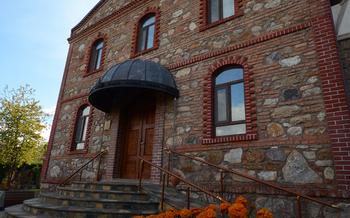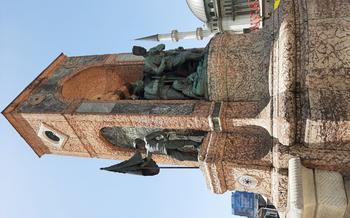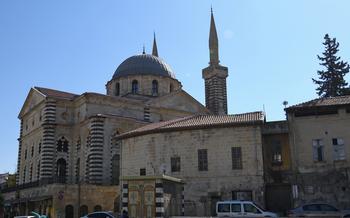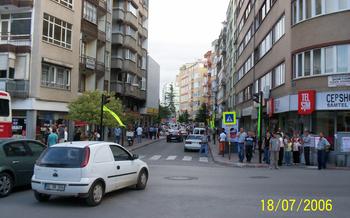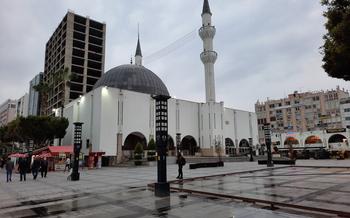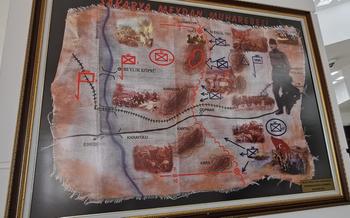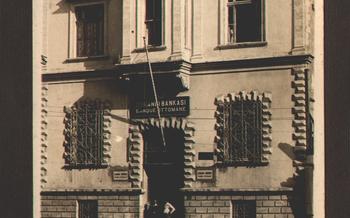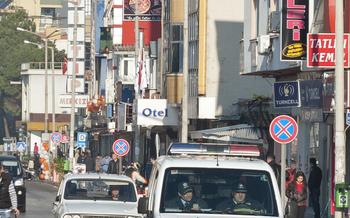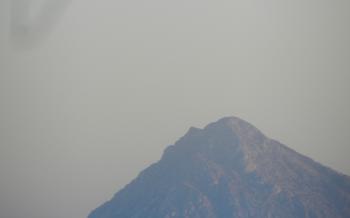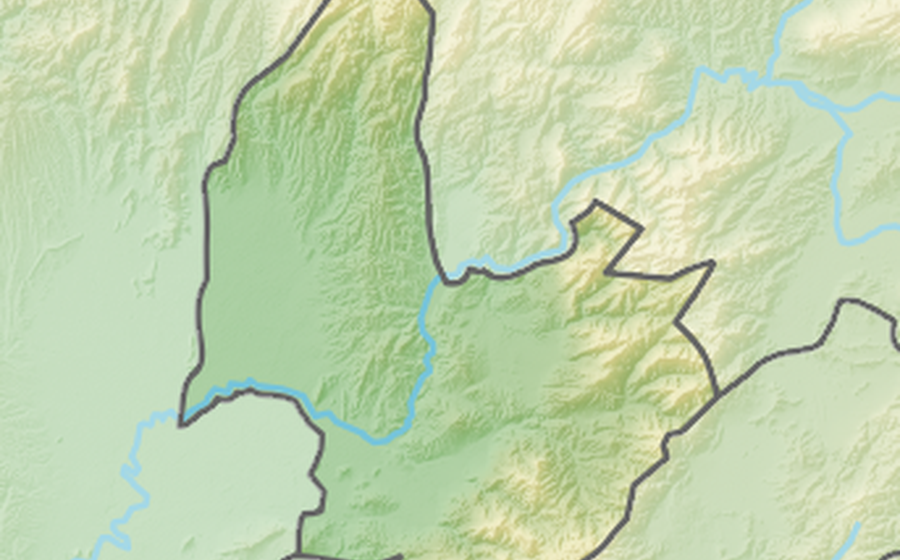
Kadirli Hacı Kuba Mosque
- History of the Kadirli Hacı Kuba Mosque
- Architectural Features
- Interior Decorations
- Religious Significance
- Cultural Symbolism
- Guided Tours and Accessibility
- Exploring the Surroundings
- Accommodations and Dining Options
- Photography and Social Media: Capturing the Essence of the Mosque
- Local Customs and Etiquette: Respecting Traditions at the Kadirli Hacı Kuba Mosque
- Historical Significance of Osmaniye
- Local Festivals and Events: A Celebration of Culture and Heritage
- Suggested Itineraries: Creating a Memorable Journey in Osmaniye
- Insider Tip: Unveiling the Hidden Gem of Kadirli Hacı Kuba Mosque
History of the Kadirli Hacı Kuba Mosque
The Kadirli Hacı Kuba Mosque, a stunning architectural masterpiece, holds a significant place in the religious and cultural heritage of Osmaniye, Turkey. Built in the 16th century during the Ottoman era, the mosque stands as a testament to the region's rich history and architectural prowess.
The mosque's construction is attributed to Hacı Kuba, a wealthy and pious merchant from the region. Inspired by his deep faith and a desire to contribute to his community, Hacı Kuba commissioned the construction of this magnificent edifice. The mosque's design and construction were entrusted to skilled architects and craftsmen of the time, who meticulously brought Hacı Kuba's vision to life.
The Kadirli Hacı Kuba Mosque showcases a harmonious blend of traditional Ottoman and Islamic architectural styles. Its striking minaret, adorned with intricate carvings and tilework, rises majestically towards the sky, symbolizing the mosque's spiritual significance. The mosque's exterior features intricate carvings and inscriptions, showcasing the artistry and attention to detail that went into its construction.
Since its inception, the Kadirli Hacı Kuba Mosque has served as a central place of worship for the Muslim community in Osmaniye. It has played a pivotal role in promoting Islamic teachings and values, contributing to the city's rich spiritual and cultural tapestry.
Architectural Features
The Kadirli Hacı Kuba Mosque stands tall, adorned with architectural elements that captivate the eyes and inspire awe. Its minaret, a symbol of Islamic architecture, rises gracefully towards the heavens, its intricate design reaching for the sky. The mosque's exterior is adorned with intricate carvings and inscriptions, each telling a story from the rich history of Islam.
Inside, the spacious prayer hall invites worshippers to gather in unity and devotion. The layout is meticulously designed to accommodate a large congregation, with rows of carpets arranged in perfect symmetry. The stained glass windows, a testament to the artistry and craftsmanship of the mosque's builders, bathe the interior in a warm and ethereal glow, adding to the serene atmosphere.
The mosque's design reflects the harmonious blend of Islamic and traditional Turkish architecture. The use of arches, domes, and minarets is a testament to the region's rich cultural heritage. The attention to detail is evident in every corner of the mosque, from the intricate carvings on the mihrab to the delicate patterns on the carpets.
The Kadirli Hacı Kuba Mosque is a masterpiece of Islamic architecture, a testament to the ingenuity and creativity of its builders. Its architectural features are a reflection of the mosque's religious and cultural significance, making it a must-see destination for anyone visiting Osmaniye.
Interior Decorations
The interior of the Kadirli Hacı Kuba Mosque is a testament to the artistry and devotion of its creators. The walls are adorned with intricate tilework and mosaics, each piece carefully arranged to create vibrant patterns and scenes. The tiles feature a variety of colors, from deep blues and greens to vibrant reds and yellows, and depict a range of motifs, including floral designs, geometric patterns, and verses from the Quran.
The calligraphy on the walls is equally impressive. Verses from the Quran and sayings of the Prophet Muhammad (PBUH) are inscribed in beautiful Arabic script, adding to the sacred atmosphere of the mosque. The mihrab, the niche indicating the direction of Mecca, is particularly noteworthy for its intricate design. It is made of carved wood and features a variety of decorative elements, including floral motifs and geometric patterns. The mihrab is a focal point of the mosque and serves as a reminder of the importance of prayer in the Muslim faith.
The chandeliers and lamps hanging from the ceiling of the mosque add to its beauty and illumination. They are made of various materials, including glass, metal, and wood, and feature intricate designs that complement the overall architecture of the mosque. The chandeliers and lamps provide a warm and inviting glow, creating a serene atmosphere conducive to prayer and contemplation.
Religious Significance
The Kadirli Hacı Kuba Mosque holds immense religious significance for Muslims in Turkey and beyond. It serves as a central place of worship for the local Muslim community, where they gather for daily prayers, including the five obligatory daily prayers (Salat). During the holy month of Ramadan, the mosque becomes even more vibrant, with special night prayers, Taraweeh, and communal Iftar (breaking of the fast) gatherings.
Beyond its role as a place of worship, the mosque also plays a crucial role in promoting Islamic teachings and values. Regular religious classes and lectures are held, where scholars and Imams impart knowledge about the Quran, Hadith, and Islamic history. These sessions provide a platform for spiritual guidance, fostering a deeper understanding of Islam among the faithful.
The mosque's contributions to the spiritual and cultural heritage of Turkey are profound. It serves as a tangible reminder of the country's rich Islamic history and the deep-rooted faith of its people. The mosque's architectural grandeur and intricate decorations reflect the artistic and cultural achievements of the region, showcasing the harmonious blend of Islamic and Turkish traditions.
Cultural Symbolism
The Kadirli Hacı Kuba Mosque stands as a testament to the rich cultural heritage of Turkey, embodying the essence of Turkish-Islamic architecture and art. Its intricate designs, stunning tilework, and graceful minaret reflect the fusion of Islamic traditions with Anatolian craftsmanship. The mosque serves as a symbol of unity and harmony among different cultures, showcasing the peaceful coexistence of various ethnicities and religions in Turkey.
Beyond its religious significance, the mosque plays a vital role in preserving and showcasing Turkish traditions. It is a place where locals gather for prayers, celebrations, and community events, fostering a sense of belonging and cultural identity. The mosque's architectural grandeur and historical significance attract tourists from around the world, contributing to the cultural exchange and understanding between different nations. As a cultural landmark, the Kadirli Hacı Kuba Mosque invites visitors to immerse themselves in the vibrant tapestry of Turkish culture and history.
Guided Tours and Accessibility
For those seeking a deeper understanding of the Kadirli Hacı Kuba Mosque and its significance, guided tours are available in various languages. These tours provide insightful narratives about the mosque's history, architecture, and religious importance. Visitors can learn about the mosque's unique features, such as its striking minaret, intricate carvings, and beautiful stained glass windows. Guided tours offer a comprehensive and enriching experience, allowing visitors to delve into the mosque's cultural and spiritual significance.
The mosque is also committed to accessibility, ensuring that visitors with disabilities can fully experience its beauty and grandeur. Wheelchair ramps, elevators, and accessible restrooms are available to facilitate ease of movement throughout the mosque. Visitors with disabilities can enjoy the mosque's serene atmosphere and participate in religious ceremonies without any hindrance.
To book a guided tour or inquire about accessibility features, visitors can contact the mosque's administration office or local tour operators. These tours offer a structured and informative experience, allowing visitors to make the most of their visit to the Kadirli Hacı Kuba Mosque.
Exploring the Surroundings
Beyond the Kadirli Hacı Kuba Mosque, the city of Osmaniye offers an array of attractions for visitors to explore. Just a short distance away lies the Osmaniye Museum, a treasure trove of artifacts and exhibits that narrate the rich history and culture of the region. Immerse yourself in the stories of ancient civilizations, admire traditional handicrafts, and gain insights into the diverse heritage of Osmaniye.
For those seeking a deeper connection with nature, the stunning waterfalls of Karagözlü are a must-visit. Located a scenic drive from the city, these cascading waters offer a breathtaking spectacle, surrounded by lush greenery and tranquil surroundings. Take a leisurely hike amidst the picturesque landscapes, capture the beauty of the falls on camera, and soak in the serenity of this natural wonder.
Enthusiasts of ancient history will find solace in the nearby ruins of Karatepe-Aslantaş. Unearth the secrets of this once-thriving city, explore the remnants of its fortifications, and marvel at the well-preserved hieroglyphic inscriptions that provide a glimpse into the past.
To experience the vibrant spirit of Osmaniye, venture into the local markets, where you can haggle for unique souvenirs, sample delicious street food, and immerse yourself in the bustling atmosphere. Join the locals as they go about their daily lives, discover hidden gems and artisan workshops, and take home a piece of Osmaniye's vibrant culture.
Whether you seek historical wonders, natural beauty, or cultural immersion, Osmaniye offers a wealth of experiences to create a truly memorable journey.
Accommodations and Dining Options
When planning your trip to visit the Kadirli Hacı Kuba Mosque, finding suitable accommodations and dining options is essential. Here are some recommendations to ensure a comfortable and enjoyable stay:
Accommodations:
- Hotels and Guesthouses:
- For a luxurious stay, consider the five-star Kadirli Plaza Hotel, offering stunning city views and modern amenities.
-
For a budget-friendly option, the Kadirli Hanzade Hotel provides clean and comfortable rooms at affordable rates.
-
Local Hospitality:
- Immerse yourself in Turkish culture by opting for local guesthouses or homestays. This offers a unique opportunity to interact with locals and experience their way of life.
Dining Options:
- Traditional Turkish Cuisine:
- Savor the flavors of Turkish delights at local restaurants like the Kadirli Sofrası, renowned for its authentic kebabs and mezzes.
-
For a taste of traditional Turkish breakfast, visit the Kadirli Kahvaltı Salonu, serving a variety of fresh cheeses, olives, and homemade jams.
-
International Cuisine:
-
For those seeking international flavors, the city offers a range of restaurants serving Italian, Chinese, and Indian cuisines.
-
Budget-Friendly Options:
-
Explore the local markets for fresh produce, snacks, and street food. This is a great way to sample local delicacies at affordable prices.
-
Insider Tip:
- Don't miss the chance to try "cezerye," a traditional Turkish delight made from carrots and walnuts, a specialty of the Osmaniye region.
Photography and Social Media: Capturing the Essence of the Mosque
When visiting the Kadirli Hacı Kuba Mosque, capturing the beauty and serenity of the space through photography can be a rewarding experience. However, it's important to be respectful and mindful of the sanctity of the mosque when taking photos.
- Guidelines for Photography:
- Respectful Approach: Be mindful of worshippers and avoid disrupting their prayers or religious activities.
- No Flash Photography: Flash photography is generally not allowed inside the mosque to preserve the ambiance.
- Tripods and Selfie Sticks: The use of tripods and selfie sticks may be restricted to ensure safety and prevent damage.
-
Modest Attire: Dress modestly and appropriately, avoiding revealing clothing or shorts.
-
Social Media and Sharing:
- Share Experiences: Share your experiences and photos on social media to inspire others to visit the mosque.
- Tag and Credit: Tag the mosque's official social media accounts and credit the photographer when sharing photos.
-
Respect Privacy: Avoid taking photos of individuals without their consent, especially during prayer.
-
Capturing the Mosque's Essence:
- Architectural Details: Showcase the intricate carvings, stained glass windows, and unique features of the mosque's architecture.
- Interior Beauty: Capture the vibrant tilework, calligraphy, and ornate chandeliers that adorn the prayer hall.
- Spiritual Moments: Photograph worshippers engaged in prayer, capturing the serenity and devotion within the mosque.
- Cultural Interactions: Document interactions with locals, showcasing the warmth and hospitality of the community.
Remember, the Kadirli Hacı Kuba Mosque is a sacred place of worship, and respecting the religious and cultural significance of the site is essential. By following these guidelines, you can capture the essence of the mosque while ensuring a respectful and enriching experience for all visitors.
Local Customs and Etiquette: Respecting Traditions at the Kadirli Hacı Kuba Mosque
When visiting the Kadirli Hacı Kuba Mosque, it is important to be mindful of local customs and etiquette to ensure a respectful and enjoyable experience. Here are a few guidelines to keep in mind:
-
Dress Code: Dress modestly and appropriately when visiting the mosque. For men, long pants and a shirt with sleeves are recommended. Women should cover their hair with a headscarf and wear loose-fitting clothing that covers their arms and legs.
-
Footwear: Before entering the prayer hall, remove your shoes and place them neatly on the designated shoe racks. It is considered disrespectful to enter the prayer area with shoes on.
-
Silence and Respect: The mosque is a place of worship and tranquility. Maintain silence and avoid loud conversations or disruptive behavior. Be respectful of those who are praying or engaged in religious activities.
-
Photography and Social Media: While it is permitted to take photos of the mosque's exterior and certain areas of the interior, always ask permission before photographing people or religious ceremonies. Be mindful of the sanctity of the mosque and avoid using flash photography or causing any disturbance.
-
Interaction with Locals: When interacting with locals, be polite and respectful. A friendly smile and greeting can go a long way. If you are unsure about something, do not hesitate to ask for assistance or guidance from the mosque staff or fellow visitors.
By following these guidelines, you can contribute to preserving the sanctity of the Kadirli Hacı Kuba Mosque and ensure a pleasant and meaningful visit for yourself and others.
Historical Significance of Osmaniye
Osmaniye, a city in southern Turkey, holds a rich historical significance that dates back to ancient times. Once known as "Haciveli," it was a significant center during the Roman Empire and later became part of the Byzantine Empire. The city's strategic location on the trade routes between the Mediterranean Sea and the Anatolian interior made it a hub of commerce and cultural exchange.
In the 11th century, the Seljuk Turks conquered the region, and Osmaniye became an important city in the Beylik of Teke. During this period, the city's infrastructure and cultural heritage flourished, with the construction of mosques, caravanserais, and other architectural marvels.
Osmaniye's history is intertwined with the rise of the Ottoman Empire. In the 15th century, the Ottomans incorporated the city into their vast empire, and it became a center of administration and governance. The Ottomans left a lasting impact on the city, contributing to its architectural landscape and cultural identity.
Throughout history, Osmaniye has been a melting pot of different cultures, including Greek, Armenian, and Turkish. This diversity has shaped the city's unique heritage, evident in its cuisine, traditions, and landmarks.
In the 20th century, Osmaniye underwent significant modernization and industrialization, transforming into a vibrant and progressive city. Today, it stands as a testament to its rich past, blending historical charm with modern amenities, inviting visitors to explore its captivating story.
Local Festivals and Events: A Celebration of Culture and Heritage
Osmaniye's vibrant cultural scene is brought to life by a plethora of local festivals and events that showcase the city's rich heritage and traditions. These celebrations offer travelers a unique opportunity to immerse themselves in the local way of life and experience the warmth and hospitality of the Turkish people.
The Osmaniye Cherry Festival, held annually in June, is a delightful celebration of the region's famous cherries. Visitors can indulge in delicious cherry-based delicacies, witness traditional cherry-picking competitions, and enjoy live music and cultural performances.
The Osmaniye Carpet Festival, held in September, pays homage to the city's renowned carpet-weaving tradition. Visitors can marvel at intricate handmade carpets, participate in workshops to learn the art of carpet weaving, and witness traditional carpet-making demonstrations.
For those interested in history and culture, the Osmaniye History and Culture Festival is a must-attend event. Held in October, the festival features exhibitions, conferences, and workshops that delve into the city's rich past and cultural heritage.
These local festivals and events are not only a celebration of Osmaniye's unique identity but also a testament to the city's commitment to preserving and promoting its cultural traditions. Participating in these events is a wonderful way for travelers to connect with the local community, embrace the Turkish way of life, and create lasting memories.
Suggested Itineraries: Creating a Memorable Journey in Osmaniye
One-Day Itinerary:
- Morning: Begin your day by exploring the Kadirli Hacı Kuba Mosque, marveling at its architectural splendor and intricate details. Immerse yourself in its religious significance and learn about its role in the community.
- Afternoon: Visit the Osmaniye Museum to delve into the city's rich history and cultural heritage. Discover the fascinating stories and artifacts that showcase Osmaniye's past.
- Evening: Stroll along the scenic Ceyhan River, enjoying the tranquil atmosphere and admiring the stunning sunset views. Indulge in a delicious dinner at a local restaurant, savoring the flavors of traditional Turkish cuisine.
Two-Day Itinerary:
- Day 1 (Morning): Explore the Kadirli Hacı Kuba Mosque, appreciating its architectural beauty and religious significance. Visit the nearby Grand Bazaar, where you can immerse yourself in the vibrant atmosphere and shop for unique souvenirs.
- Day 1 (Afternoon): Discover the ancient ruins of Anavarza, a testament to the region's rich history. Explore the well-preserved structures and imagine the grandeur of this once-thriving city.
- Day 2 (Morning): Embark on a scenic boat trip on the Ceyhan River, admiring the picturesque landscapes and tranquil waters. Visit the Osmaniye Bird Sanctuary to observe the diverse birdlife and enjoy the serene natural surroundings.
- Day 2 (Afternoon): Immerse yourself in the local culture by visiting traditional Turkish coffeehouses and savoring the aromatic flavors of freshly brewed coffee. Experience the warmth and hospitality of the locals as you engage in conversations and learn about their way of life.
Three-Day Itinerary:
- Day 1: Follow the One-Day Itinerary above.
- Day 2: Explore the ancient ruins of Anavarza and take a scenic boat trip on the Ceyhan River.
- Day 3 (Morning): Visit the Osmaniye Museum and discover the city's rich history and cultural heritage. Learn about the unique traditions and customs that have shaped Osmaniye's identity.
- Day 3 (Afternoon): Indulge in a rejuvenating Turkish bath experience, immersing yourself in the soothing steam and enjoying a traditional massage. Relax and unwind as you embrace the tranquility of this ancient bathing ritual.
Insider Tip: Unveiling the Hidden Gem of Kadirli Hacı Kuba Mosque
Beyond its architectural grandeur, Kadirli Hacı Kuba Mosque holds a hidden gem that often goes unnoticed by visitors. Tucked away in a serene corner of the mosque's courtyard is a small, unassuming fountain known as the "Wishing Well." According to local legend, visitors who toss a coin into the well and make a sincere wish will have their desires granted. While the authenticity of this belief remains a mystery, the Wishing Well adds a touch of enchantment to the mosque's already captivating atmosphere.
For those seeking a unique souvenir from Osmaniye, venture into the bustling local markets near the mosque. Here, you'll find an array of handcrafted treasures, from intricate carpets and pottery to traditional Turkish jewelry and textiles. Haggling is not only acceptable but expected, so don't be afraid to engage in friendly negotiations with the vendors.
As you soak in the vibrant atmosphere of Osmaniye, be sure to savor the delectable local cuisine. Indulge in mouthwatering kebabs, freshly baked pide bread, and the region's signature dish, Osmaniye künefesi, a sweet shredded wheat pastry drenched in syrup and topped with clotted cream.
My personal anecdote from visiting Kadirli Hacı Kuba Mosque involves a chance encounter with a local family. While admiring the mosque's stunning architecture, I struck up a conversation with an elderly woman who shared fascinating stories about her childhood in Osmaniye. Her tales of the city's rich history and traditions left me with a deeper appreciation for this vibrant and welcoming community.
